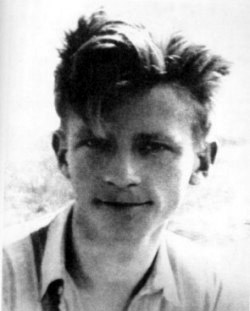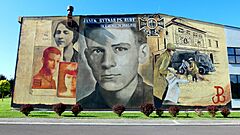Jan Bytnar facts for kids
Quick facts for kids
Jan Bytnar
"Rudy", "Czarny", "Janek", "Krokodyl", "Jan Rudy" |
|
|---|---|
 |
|
| Born | 6 May 1921 Kolbuszowa, Poland |
| Died | 30 March 1943 (aged 21) Warsaw, Poland |
| Allegiance | Poland |
| Service/ |
Armia Krajowa (Home Army) |
| Rank | Second Lieutenant |
| Battles/wars | World War II |
| Awards | Krzyż Walecznych (Cross of Valour) Commander's Cross of the Order of Polonia Restituta |
Jan Roman Bytnar was a brave Polish scout and soldier. His secret wartime name was "Rudy," which means "Ginger." He was born on May 6, 1921, in Kolbuszowa, Poland.
Jan Bytnar was a scoutmaster and a member of the Gray Ranks. This was a secret scouting group that fought against the Nazis during World War II. He also became a lieutenant in the Home Army, a Polish underground army. He sadly died on March 30, 1943, in Warsaw, Poland, at just 21 years old.
Contents
Jan Bytnar's Early Life and Education
Jan Bytnar's father, Stanisław Bytnar, was a teacher and a soldier. His mother was Zdzisława Rechulówna. Jan went to elementary school in a town called Piastów.
In 1931, his family moved to Warsaw. Jan was accepted into the Stefan Batory Gymnasium, which was a high school. They lived in the Mokotów area of the city.
Joining the Scouts
When Jan was 13, in 1934, he joined the Polish Scouting and Guiding Association. He was a very dedicated scout. By 1938, he earned the highest rank for a scout who wasn't an instructor, called "Scout of the Republic."
In 1937, he started attending a lyceum, which is a type of secondary school. He finished his studies in May 1939, just before World War II began.
Fighting for Freedom in World War II
After Germany invaded Poland in September 1939, Jan Bytnar lived in Warsaw, which was under German control. He worked as a glazier, fixing windows, and also tutored students.
In October 1939, Jan and his friends joined a secret group called the Polish People's Independent Action (PLAN). This group was against the Nazis. He helped write and hand out leaflets to protest the German occupation.
Joining the Resistance Movement
The PLAN group was soon discovered by the Gestapo, the German secret police. By January 1940, the group was broken up. Jan left Warsaw and stayed with his grandparents in Kolbuszowa. There, he continued to be involved in the resistance against the Nazis.
Early in 1940, he joined the Union of Armed Struggle. This group later became known as the Home Army. In March 1941, Jan became a member of the Gray Ranks. This was a secret scouting organization that carried out acts of sabotage against the Germans.
Jan Bytnar and his team focused on "small sabotage." This meant doing small acts of resistance, like painting anti-Nazi slogans on walls or damaging German property. They were part of a group called the Wawer Group.
Arrest, Death, and Rescue Mission
Jan Bytnar was arrested by the Nazis on March 23, 1943. He was held captive and questioned. Three days later, on March 26, a brave group from the Gray Ranks launched a daring rescue mission. This mission was called Operation Arsenal.
They successfully rescued Jan Bytnar. However, he had been badly injured during the questioning by the Gestapo. He died from these injuries on March 30, 1943, at the age of 21.
Justice for Jan Bytnar
The German officers who were responsible for Jan Bytnar's injuries were Ewald Lange and Herbert Schultz. Later, members of the Gray Ranks found them. Schultz was shot and killed on May 6, 1943, by Sławomir Maciej Bittner and Eugeniusz Kecher. Lange was shot and killed on May 22, 1943, by Jerzy Zapadko.
On April 4, 1946, Jan Bytnar was buried in a shared grave. His close friend, Maciej Dawidowski, who was also a member of the Szare Szeregi and died on the same day during the war, was buried with him. Their grave is at the Powązki Military Cemetery.
Jan Bytnar in Books, Films, and Music
Jan Bytnar's story has inspired many works of art. He is the main character in Stones for the Rampart by Aleksander Kamiński. This book is considered a classic for teenagers and young adults in Polish literature. He is also featured in Rudy, Alek, Zośka by Barbara Wachowicz.
His story was told in the 1977 historical film Akcja pod Arsenałem, directed by Jan Łomnicki. In this film, Jan Bytnar is played by Cezary Morawski.
In a 2010 documentary film called Oni szli Szarymi Szeregami, Bartłomiej Firlet played Jan Bytnar.
Jan Bytnar's capture also inspired a song. The Polish singer Dawid Podsiadło released a song in 2014 called 4:30. The title refers to the time Jan Bytnar was arrested by the Gestapo on March 23, 1943. This song is also in the 2014 war drama film Stones for the Rampart. In that film, Tomasz Ziętek plays Jan Bytnar.
Honoring Jan Bytnar's Legacy
In 1943, Jan Bytnar was given the Cross of Valour. This award is for showing great courage during wartime. In 2009, after his death, he was also awarded the Commander's Cross of the Order of Polonia Restituta by the President of Poland.
There is a special plaque on the house where Jan Bytnar was born in Kolbuszowa. In 1980, another plaque was placed at the entrance of the building in Warsaw where he lived and was arrested.
Many streets in Poland are named after him, including in Warsaw, Opole, and Kolbuszowa. He is also the patron, or honorary leader, of 150 Polish scout teams and many schools across Poland.
See also
- Polish Secret State
- Związek Harcerstwa Polskiego
- Mury
- Battalion Zośka
- Battalion Parasol


